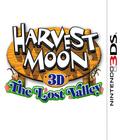Harvest Moon The Lost Valley has a fully customizable world, and players can customize their field in any way they see fit: from a field full of tulips like you might see in Holland, to a valley filled with water like Venice, the choice is up to you.
You've never played a Harvest Moon game quite like this!
Producer Taka Maekawa reveals the new crop system within The Lost Valley.
"Let's start with the simple, unassuming cabbage: You plant it, water it, and when it comes time to harvest it, you'll have a traditional, normal, green cabbage, right?" said Taka Maekawa, Producer of Harvest Moon: The Lost Valley. "Nope! Not in this game!"
In Harvest Moon: The Lost Valley, each crop has numerous variants that players will need to discover! This goes beyond both the regular and "giant" versions of crops found in games like Harvest Moon: A New Beginning, but also mutations, such as purple flowers growing from pink seeds, pearl onions growing from a normal onion seeds, and even some mysterious pumpkin mutations that may grow when planted in swampy ground...all of this brings players to more than 100 crops!
Players will need to experiment to discover all the different crop variations, and to do so, they'll need to think outside the traditional field. With the capacity to plant anywhere within the Lost Valley, crops can be sowed at higher or lower elevations, closer to or further away from water, on dry land or swampy ground. Not every plant in these locations may result in a mutated plant, so farmers will need to keep trying for rare veggies and flowers!
Again, using Cabbage as an example, this crop will have ten variations, including the Giant Cabbage, Red Cabbage, and more, which all reflect how the crop was grown. It will be up to the adventurous player to discover all the variations of each crop -- are you ready to take on the challenge of becoming a crop-growing expert?
More articles about Harvest Moon: The Lost Valley











 In Harvest Moon: The Lost Valley, players experience the role-playing farm simulation in a three-dimensional setting for the first time.
In Harvest Moon: The Lost Valley, players experience the role-playing farm simulation in a three-dimensional setting for the first time.











